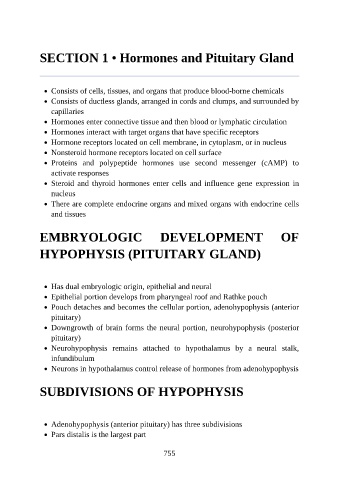Page 756 - Atlas of Histology with Functional Correlations
P. 756
SECTION 1 • Hormones and Pituitary Gland
Consists of cells, tissues, and organs that produce blood-borne chemicals
Consists of ductless glands, arranged in cords and clumps, and surrounded by
capillaries
Hormones enter connective tissue and then blood or lymphatic circulation
Hormones interact with target organs that have specific receptors
Hormone receptors located on cell membrane, in cytoplasm, or in nucleus
Nonsteroid hormone receptors located on cell surface
Proteins and polypeptide hormones use second messenger (cAMP) to
activate responses
Steroid and thyroid hormones enter cells and influence gene expression in
nucleus
There are complete endocrine organs and mixed organs with endocrine cells
and tissues
EMBRYOLOGIC DEVELOPMENT OF
HYPOPHYSIS (PITUITARY GLAND)
Has dual embryologic origin, epithelial and neural
Epithelial portion develops from pharyngeal roof and Rathke pouch
Pouch detaches and becomes the cellular portion, adenohypophysis (anterior
pituitary)
Downgrowth of brain forms the neural portion, neurohypophysis (posterior
pituitary)
Neurohypophysis remains attached to hypothalamus by a neural stalk,
infundibulum
Neurons in hypothalamus control release of hormones from adenohypophysis
SUBDIVISIONS OF HYPOPHYSIS
Adenohypophysis (anterior pituitary) has three subdivisions
Pars distalis is the largest part
755

